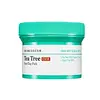What's inside
What's inside
 Key Ingredients
Key Ingredients

 Benefits
Benefits

 Concerns
Concerns

 Ingredients Side-by-side
Ingredients Side-by-side

Water
Skin ConditioningKaolin
AbrasiveButylene Glycol
HumectantGlycerin
HumectantArtemisia Vulgaris Extract
Skin ConditioningDiglycerin
HumectantMica
Cosmetic ColorantPEG-32
HumectantSodium Palmitate
CleansingGlyceryl Polymethacrylate
Pvm/Ma Copolymer
Emulsion StabilisingCeramide EOP
Skin ConditioningCeramide AP
Skin ConditioningCeramide Ns
Skin ConditioningCeramide As
Skin ConditioningCeramide NP
Skin ConditioningCI 77289
Cosmetic ColorantPhenoxyethanol
PreservativePEG-40 Hydrogenated Castor Oil
EmulsifyingCI 77492
Cosmetic ColorantMenthyl Lactate
MaskingBeta-Glucan
Skin ConditioningCurcuma Longa Root Extract
MaskingVerbascum Thapsus Extract
Skin ConditioningNiacinamide
SmoothingCentella Asiatica Extract
CleansingSalicylic Acid
MaskingPinus Densiflora Leaf Extract
AntimicrobialLactobacillus Ferment Lysate
Skin ConditioningSaccharide Isomerate
HumectantHydroxypropyl Cyclodextrin
MaskingDipropylene Glycol
HumectantRhamnose
Humectant1,2-Hexanediol
Skin ConditioningWater, Kaolin, Butylene Glycol, Glycerin, Artemisia Vulgaris Extract, Diglycerin, Mica, PEG-32, Sodium Palmitate, Glyceryl Polymethacrylate, Pvm/Ma Copolymer, Ceramide EOP, Ceramide AP, Ceramide Ns, Ceramide As, Ceramide NP, CI 77289, Phenoxyethanol, PEG-40 Hydrogenated Castor Oil, CI 77492, Menthyl Lactate, Beta-Glucan, Curcuma Longa Root Extract, Verbascum Thapsus Extract, Niacinamide, Centella Asiatica Extract, Salicylic Acid, Pinus Densiflora Leaf Extract, Lactobacillus Ferment Lysate, Saccharide Isomerate, Hydroxypropyl Cyclodextrin, Dipropylene Glycol, Rhamnose, 1,2-Hexanediol
Water
Skin ConditioningKaolin
AbrasiveDipropylene Glycol
HumectantCentella Asiatica Extract
CleansingMelaleuca Alternifolia Leaf Extract
PerfumingBentonite
AbsorbentBetaine
HumectantAlcohol Denat.
AntimicrobialSilica
Abrasive1,2-Hexanediol
Skin ConditioningPolyglyceryl-4 Caprate
EmulsifyingCoco-Glucoside
CleansingCellulose
AbsorbentMelaleuca Alternifolia Flower/Leaf/Stem Extract
Skin ConditioningSodium Hyaluronate
HumectantCalamine
AbsorbentXanthan Gum
EmulsifyingChlorella Vulgaris Powder
Skin ConditioningGluconolactone
Skin ConditioningTriethoxycaprylylsilane
Illite
AbrasiveMontmorillonite
AbsorbentManicouagan Clay
AbsorbentCanadian Colloidal Clay
Skin ConditioningHydrolyzed Sodium Hyaluronate
Skin ConditioningHydrolyzed Hyaluronic Acid
HumectantHectorite
AbsorbentHydroxyacetophenone
AntioxidantEthylhexylglycerin
Skin ConditioningWater, Kaolin, Dipropylene Glycol, Centella Asiatica Extract, Melaleuca Alternifolia Leaf Extract, Bentonite, Betaine, Alcohol Denat., Silica, 1,2-Hexanediol, Polyglyceryl-4 Caprate, Coco-Glucoside, Cellulose, Melaleuca Alternifolia Flower/Leaf/Stem Extract, Sodium Hyaluronate, Calamine, Xanthan Gum, Chlorella Vulgaris Powder, Gluconolactone, Triethoxycaprylylsilane, Illite, Montmorillonite, Manicouagan Clay, Canadian Colloidal Clay, Hydrolyzed Sodium Hyaluronate, Hydrolyzed Hyaluronic Acid, Hectorite, Hydroxyacetophenone, Ethylhexylglycerin
 Reviews
Reviews

Ingredients Explained
These ingredients are found in both products.
Ingredients higher up in an ingredient list are typically present in a larger amount.
1,2-Hexanediol is a synthetic liquid and another multi-functional powerhouse.
It is a:
- Humectant, drawing moisture into the skin
- Emollient, helping to soften skin
- Solvent, dispersing and stabilizing formulas
- Preservative booster, enhancing the antimicrobial activity of other preservatives
Centella Asiatica Extract (Centella) is derived from an herb native to Southeast Asia. It is famous for its anti-inflammatory and soothing properties.
Centella is rich in antioxidants and amino acids, such as Madecassic Acid and Asiaticoside.
Studies show the compounds in centella help with:
The combination of all these properties makes centella effective at soothing, hydrating, and protecting the skin.
Other great components of centella include Vitamin A, vitamin C, several B vitamins, and Asiatic Acid.
Fun fact: Centella has been used as a medicine and in food for many centuries. As a medicine, it is used to treat burns, scratches, and wounds.
Learn more about Centella Asiatica ExtractDipropylene Glycol is a synthetically created humectant, stabilizer, and solvent.
This ingredient helps:
Dipropylene glycol is technically an alcohol, but it belongs to the glycol family (often considered part of the ‘good’ alcohols). This means it is hydrating and gentle on skin unlike drying solvent alcohols like denatured alcohol.
As a masking agent, Dipropylene Glycol can be used to cover the smell of other ingredients. However, it does not have a scent.
Studies show Dipropylene Glycol is considered safe to use in skincare.
Learn more about Dipropylene GlycolKaolin is a clay. It is used for oil control and to help minimize pores. Like other clays, kaolin has the ability to absorb excess sebum or oil. This can help clean out pores and mattify the skin.
Some types of kaolin may have exfoliating properties. When water is added to kaolin, it becomes a paste with small abrasive particles.
Most kaolin is a white color, but may be pink/orange/red depending on where it comes from.
The name 'kaolin' comes from a Chinese village named 'Gaoling'. Kaolin clay comes from rocks rich in kaolinite. Kaolinite, the mineral, has a silicate layered structure. Kaolinite is formed from chemical weathering of aluminum siilicate minerals.
Besides skincare, kaolin is commonly used to make glossy paper, in ceramics, toothpaste, and as medicine to soothe stomach issues.
Learn more about KaolinWater. It's the most common cosmetic ingredient of all. You'll usually see it at the top of ingredient lists, meaning that it makes up the largest part of the product.
So why is it so popular? Water most often acts as a solvent - this means that it helps dissolve other ingredients into the formulation.
You'll also recognize water as that liquid we all need to stay alive. If you see this, drink a glass of water. Stay hydrated!
Learn more about Water